Ten types of cataract
1.Nuclear Sclerotic Cataract
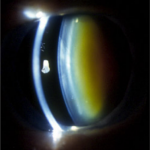 This describes an initial yellowing then brownish discoloration of the central part of the ageing lens. It is one of the more common types of cataract and occurs mostly as a result of getting older.
This describes an initial yellowing then brownish discoloration of the central part of the ageing lens. It is one of the more common types of cataract and occurs mostly as a result of getting older.
2. Cortical Cataract
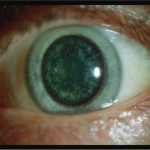 This describes an opacification of the outer part of the lens which often resembles the spokes of a bicycle as it forms in a radial pattern.
This describes an opacification of the outer part of the lens which often resembles the spokes of a bicycle as it forms in a radial pattern.
3. Posterior subcapsular cataract
 This refers to a cataract that forms diffusely along the back surface of the lens and just in front of the posterior capsular bag.
This refers to a cataract that forms diffusely along the back surface of the lens and just in front of the posterior capsular bag.
People who take steroids, diabetics and patients with retinitis pigmentosa can develop this type of cataract and it can progress quite quickly affecting reading vision and cause troublesome glare from lights.
4. Diabetic cataract
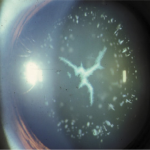 This rare type of cataract forms in diabetic patients where high blood sugars cause metabolic oxidation within the human lens resembling a ‘snowflake’.
This rare type of cataract forms in diabetic patients where high blood sugars cause metabolic oxidation within the human lens resembling a ‘snowflake’.
People who take steroids, diabetics and patients with retinitis pigmentosa can develop this type of cataract and it can progress quite quickly affecting reading vision and cause troublesome glare from lights.
5. Morgagnian Cataract
 This refers to the formation of a very advanced (hyper mature) cataract where the outer cortex has undergone complete liquefaction and the nucleus sinks to the bottom of the eye.
This refers to the formation of a very advanced (hyper mature) cataract where the outer cortex has undergone complete liquefaction and the nucleus sinks to the bottom of the eye.
6. Christmas Tree or Polychromatic Cataract
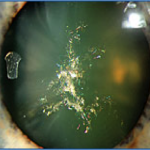 This rare type of cataract refers to the appearance of colourful, iridescent crystals that form within the lens. This can be seen as a variant of the ageing type of cataract or rarely as a complication of myotonic dystrophy.
This rare type of cataract refers to the appearance of colourful, iridescent crystals that form within the lens. This can be seen as a variant of the ageing type of cataract or rarely as a complication of myotonic dystrophy.
7. Congenital Cataract
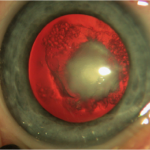 Cataracts can appear at birth and occur in one or both eyes. They can occur without cause or be related to an associated systemic disease such as rubella.
Cataracts can appear at birth and occur in one or both eyes. They can occur without cause or be related to an associated systemic disease such as rubella.
8. Posterior Polar Cataract
 This refers to the development of an opacity along the back surface of the lens near the posterior capsule and can sometimes project forward in a cylindrical shape.
This refers to the development of an opacity along the back surface of the lens near the posterior capsule and can sometimes project forward in a cylindrical shape.
This type of cataract is usually congenital and affects both eyes.
If the opacity is small, the patient may not notice any symptoms but once enlarged the cataract can be quite visually problematic.
9. Traumatic Cataract
 Injury to the eye can result in cataract and can form some interesting patterns as a result.
Injury to the eye can result in cataract and can form some interesting patterns as a result.
Here a cataract has formed as a result of blunt injury from a fist.
10. White Cataract
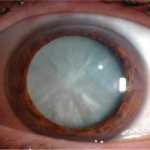 This is a very advanced form of cataract and can be very dense when removing at the time of cataract surgery.
This is a very advanced form of cataract and can be very dense when removing at the time of cataract surgery.
Care must be taken when opening the capsular bag when accessing the cataract as it may tear around the capsular bag suddenly resulting in the cataract dropping into the vitreous gel of the eye
Read more about Private cataract surgery here.

![Five Facts about Toric Intra-ocular Lenses [Infographic]](https://jaheedkhan.co.uk/wp-content/uploads/2016/12/jk-toric-lenses-500x383.jpg)